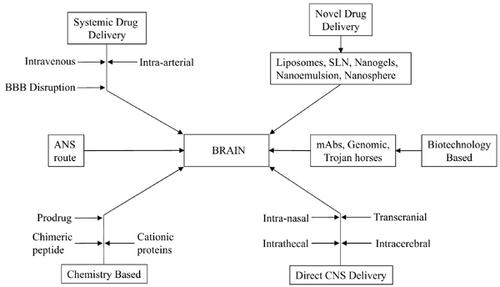Recent Patents on Nanotechnology ( IF 2.0 ) Pub Date : 2020-08-31 , DOI: 10.2174/1872210514666200508121050 Ruchita Singh 1 , Charles Brumlik 1 , Mandar Vaidya 1 , Abhishek Choudhury 1

|
Background: Current cerebral drug delivery to the brain and Cerebrospinal Fluid (CSF) is limited by the Blood-Brain Barrier (BBB) or the blood-blood Cerebrospinal Fluid (CSF) barrier. The popular, non-invasive, intranasal delivery provides an exciting route for topical and systemic applications. For example, intranasal drug delivery of Central Nervous System (CNS) drugs can be designed to pass the BBB barrier via the nose-to-brain pathways. Recent nanotechnology research and patenting focus mainly on overcoming typical limitations including bioavailability, transport, BBB penetration, targeted delivery, controlled release rate and controlled degradation.
Objective: The aim of the present study was to assess the state-of-the-art of nose-to-brain drug delivery systems and the role of nanotechnology in targeted delivery for the treatment of CNS and related therapeutic conditions.
Methods: Patent and related searches were made with analytics to explore and organize nanotech work in intranasal drug delivery to the brain. Technical advancements were mapped by API, formulation and performance criteria. Patents and published patent applications were searched with concept tables of keywords, metadata (e.g., assignee) and patent classes (e.g., International Patent Classes and Cooperative Patent Classes).
Results: The reviewed patents and published applications show a focus on formulations and therapeutic indications related to the nano-based nose-to-brain drug delivery. The main patented materials were surface modifiers, delivery systems and excipients.
Conclusion: Surface modified nanoparticles can greatly improve drug transport and bioavailability of drugs, particularly higher molecular weight drugs. The most commonly used surface modifiers were chitosan, lectin and cyclodextrin-cross-linker complex. Nanoformulations of herbal drugs could increase drug bioavailability and reduce toxicity. Biotechnology-related drug delivery approaches such as monoclonal antibodies and genetically engineered proteins (molecular Trojan horses) deliver large molecule therapeutics.
中文翻译:

基于纳米技术的鼻对脑给药的专利审查。
背景:目前向大脑和脑脊液 (CSF) 的大脑药物输送受到血脑屏障 (BBB) 或血-血脑脊液 (CSF) 屏障的限制。流行的非侵入性鼻内给药为局部和全身应用提供了令人兴奋的途径。例如,中枢神经系统 (CNS) 药物的鼻内给药可以设计为通过鼻-脑通路通过 BBB 屏障。最近的纳米技术研究和专利申请主要集中在克服典型的局限性,包括生物利用度、运输、BBB 渗透、靶向递送、受控释放速率和受控降解。
目的:本研究的目的是评估鼻-脑给药系统的最新技术以及纳米技术在靶向给药治疗 CNS 和相关治疗条件中的作用。
方法:通过分析进行专利和相关搜索,以探索和组织将鼻内药物输送到大脑的纳米技术工作。API、配方和性能标准映射了技术进步。使用关键字、元数据(例如,受让人)和专利类别(例如,国际专利类别和合作专利类别)的概念表来搜索专利和公开的专利申请。
结果:经审查的专利和已公布的申请重点关注与基于纳米的鼻-脑给药相关的配方和治疗适应症。主要的专利材料是表面改性剂、输送系统和赋形剂。
结论:表面修饰的纳米粒子可以大大提高药物的转运和生物利用度,尤其是高分子量药物。最常用的表面改性剂是壳聚糖、凝集素和环糊精-交联剂复合物。草药的纳米制剂可以提高药物的生物利用度并降低毒性。生物技术相关的药物输送方法,如单克隆抗体和基因工程蛋白(分子特洛伊木马),可提供大分子疗法。











































 京公网安备 11010802027423号
京公网安备 11010802027423号